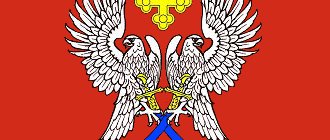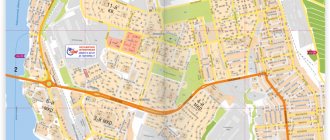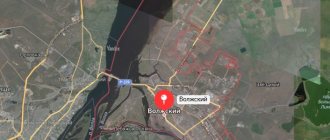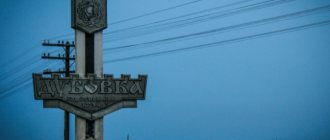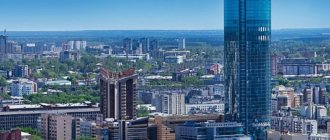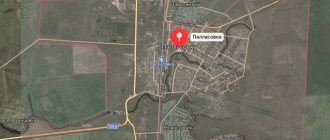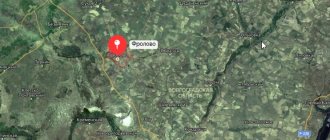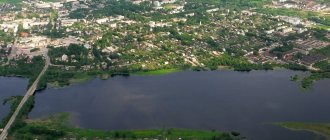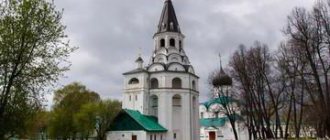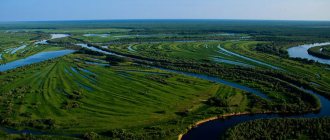This term has other meanings, see Leninsk.
| City Leninsk A country
| |||||||||||||||||||||||||||||
| Leninsk Moscow |
| Volgograd Leninsk |
K: Settlements founded in 1802
Leninsk
- a city (since 1963) in the Volgograd region of Russia, the administrative center of the Leninsky district, forms the urban settlement of the city of Leninsk.
Population - 15,353[1] people. (2016).
Story
The historical past of the city goes back to the 18th century, when, by decree of Catherine II, 1,300 peasant families from central Russia were resettled to the Trans-Volga region for work related to the production of silk fabrics. These settlers laid the foundation for the villages of Prishib, Zaplavnoe, etc.
The date of foundation of the village of Prishib (now the city of Leninsk) in the Tsaritsyn district of the Astrakhan province (not to be confused with the village of the same name in the Enotaevskaya district on the banks of the Volga River, founded in 1770) is considered to be 1776, and already according to the 4th revision of 1783, people lived in the village 500 male souls.
The village developed dynamically. By the beginning of the First World War, the population of the village exceeded 25,000 people. According to the Memorial Book of the Astrakhan province for 1914, 12,687 men and 12,693 women lived in the village of Prishib, Tsarevsky district [2] / The village was one of the largest settlements in the district.
The name of the village of Prishib remained unchanged until February 16, 1919, when, after the establishment of Soviet power in the region, the VIII District Congress of Soviets decided: to rename the former village of Prishib to Leninsk, and Tsarevsky district to Leninsky and to annex Leninsky district to the Tsaritsyn province, as to the natural center, to which the population has long gravitated towards.
Years of the Great Patriotic War
During the Great Patriotic War, there were no battles in the Leninsky region, but the war reached this region. In 1942, when the Germans approached Stalingrad, the city became a front-line area for the concentration of combat reserves, an important military and food base for the fighting Stalingrad.
In the shortest possible time, the Vladimirovka-Stalingrad railway was built, connecting the Volga region with the Saratov-Astrakhan branch. With the help of this road, the shortest route was provided for the delivery of military units, equipment, ammunition, and food to Stalingrad. In 1942, Leninsk housed 24 evacuation hospitals, where more than 15 thousand people received medical care. 250 thousand people passed through the city’s evacuation points. Many orphaned children found new families in Leninsk.
Among the residents of Leninsk and the region who fought at the front, eight people were awarded the title of Hero of the Soviet Union[⇨].
Location
The location of the city of Leninsk is the southeast of the region, the left bank of the river. Akhtuba. From east to west, the length of the district’s borders is 40 km, and from north to south – 96 km.
On all sides, the Leninsky district is surrounded by other regional districts, and only in the southeast does it border with the Astrakhan region. The area it occupies is 4000 square meters. km.
Three rivers and as many large rivers flow through this area. There are about 400 lakes in the floodplain, half of them are commercial lakes.
Economy
The economy of the region is based on the production of agricultural products: vegetables, grains, etc. The region is located in a zone of risky agriculture, so high grain yields are extremely rare. The industry is represented by such enterprises as a grain elevator, a bakery, and a printing house. The city's enterprises MP "Optimist", AK 1726, the regional communication center with the post office and others provide services to the population. There is a hotel in the city. There are 3 secondary schools, 5 kindergartens, a boarding school for hearing-impaired children, PU-47 in the area. There is a teen club. House of Children's Creativity, Children's Culture Center "October" (500 places), children's music school. In 1990, a new hospital complex with 300 beds and a polyclinic building was built.
Weather
The climate here is mainly temperate continental. Winters are quite long and moderately cold. In summer the weather is quite warm, although it does not last long.
Within the boundaries of the district there are several natural zones at the same time. Among them is an absolutely unique territory in the desert zone of the dry steppes of the Lower Volga region - the Volga-Akhtuba floodplain.
It is located in the north of the delta formed by these two rivers and is an integral ecosystem, which within the boundaries of the region has divisions of administrative and territorial order. There are only a few similar places in the world, similar in their impact and scale. There is a natural park, 7 tourist bases and 6 hunting grounds. The sphere of tourism and recreation is developed.
Notes
- ↑ 123
www.gks.ru/free_doc/doc_2016/bul_dr/mun_obr2016.rar Population of the Russian Federation by municipalities as of January 1, 2021 - [aonb.astranet.ru/dl/?file=aonb.astranet.ru/kk/pdf/bm000010024.pdf All Astrakhan and the entire Astrakhan region. Memorial book of the Astrakhan province for 1914: 31st year of publication. / Ed. Astrakhan. Lip. Stat. Committee. — Astrakhan: Type. Lip. gov., 1914. - 479 p. (Administrative division of the province. List of the most important settlements...)]
- elib.shpl.ru/ru/nodes/16031-vyp-2-astrahanskaya-guberniya-po-svedeniyam-1859-goda-1861#page/58/mode/inspect/zoom/5 GPIB. Vol. 2: Astrakhan province: ... according to information from 1859. — 186
- aonb.astranet.ru/dl/?file=aonb.astranet.ru/kk/pdf/bm000010032.pdf Memorial book of the Astrakhan province for 1900: year 17 / ed. Lip. Stat. Committee. — Astrakhan: Type. Lip. ed., 1900. - 376 p. Reference information. Col. 43
- aonb.astranet.ru/dl/?file=aonb.astranet.ru/kk/pdf/bm000010032.pdf Memorial book of the Astrakhan province for 1900: year 17 / ed. Lip. Stat. Committee. — Astrakhan: Type. Lip. ed., 1900. - 376 p. Reference information. Col. 37
- vivaldi.nlr.ru/bx000002412/details All Astrakhan and the entire Astrakhan region. Memorial book of the Astrakhan province for 1905: 22nd year of publication / Ed. Astrakhan. Lip. Stat. Committee. — Astrakhan: Steam lips. typ., 1904. - 603 p.
- aonb.astranet.ru/dl/?file=aonb.astranet.ru/kk/pdf/bm000010026.pdf All Astrakhan and the entire Astrakhan region. Memorial book of the Astrakhan province for 1908: 25th year of publication. / ed. Astrakhan. Lip. Stat. Committee. — Astrakhan: Steam lips. typ., 1908. - 374 p.
- aonb.astranet.ru/dl/?file=aonb.astranet.ru/kk/pdf/bm000010029.pdf All Astrakhan and the entire Astrakhan region. Memorial book of the Astrakhan province for 1911: 28th year of publication. / ed. Astrakhan. Lip. Stat. Committee. — Astrakhan: Steam lips. typ., 1911. - 510 p. (Information department. Administrative division of the province)
- aonb.astranet.ru/dl/?file=aonb.astranet.ru/kk/pdf/bm000010024.pdf All Astrakhan and the entire Astrakhan region. Memorial book of the Astrakhan province for 1914: 31st year of publication. / Ed. Astrakhan. Lip. Stat. Committee. — Astrakhan: Type. Lip. gov., 1914. - 479 p.
- [demoscope.ru/weekly/ssp/rus59_reg2.php All-Union Population Census of 1959. The size of the urban population of the RSFSR, its territorial units, urban settlements and urban areas by gender] (Russian). Demoscope Weekly. Retrieved September 25, 2013. [www.webcitation.org/6GDOghWC9 Archived from the original on April 28, 2013].
- [demoscope.ru/weekly/ssp/rus70_reg2.php All-Union Population Census of 1970 The size of the urban population of the RSFSR, its territorial units, urban settlements and urban areas by gender.] (Russian). Demoscope Weekly. Retrieved September 25, 2013. [www.webcitation.org/6GDOiMstp Archived from the original on April 28, 2013].
- [demoscope.ru/weekly/ssp/rus79_reg2.php All-Union Population Census of 1979 The size of the urban population of the RSFSR, its territorial units, urban settlements and urban areas by gender.] (Russian). Demoscope Weekly. Retrieved September 25, 2013. [www.webcitation.org/6GDOjhZ5L Archived from the original on April 28, 2013].
- [demoscope.ru/weekly/ssp/rus89_reg2.php All-Union Population Census of 1989. Urban population]. [www.webcitation.org/617x0o0Pa Archived from the original on August 22, 2011].
- ↑ 12345678
www.MojGorod.ru/volgorad_obl/leninsk/index.html People's encyclopedia “My City”. Leninsk (Volgograd region) - [www.perepis2002.ru/ct/doc/1_TOM_01_04.xls All-Russian Population Census 2002. Volume. 1, table 4. Population of Russia, federal districts, constituent entities of the Russian Federation, districts, urban settlements, rural settlements - regional centers and rural settlements with a population of 3 thousand or more]. [www.webcitation.org/65AdCU0q3 Archived from the original on February 3, 2012].
- [www.gks.ru/bgd/regl/b08_14t/IssWWW.exe/Stg/ug/12.htm Cities of the Volgograd region (number of inhabitants - estimate as of January 1, 2008, thousand people)]. Retrieved June 10, 2021. [www.webcitation.org/6iAPnDR9L Archived from the original on June 10, 2016].
- [www.gks.ru/bgd/regl/B09_109/IssWWW.exe/Stg/d01/tabl-21-09.xls Number of permanent population of the Russian Federation by cities, urban-type settlements and districts as of January 1, 2009]. Retrieved January 2, 2014. [www.webcitation.org/6MJmu0z1u Archived from the original on January 2, 2014].
- volgastat.gks.ru/wps/wcm/connect/rosstat_ts/volgastat/resources/fb8a0f004fe3ed6b85a4edd8c740ec4f/t1_14.pdf All-Russian Population Census 2010. Population of urban districts, municipal districts, urban and rural settlements, urban and rural settlements of the Volgograd region
- [www.gks.ru/free_doc/doc_2012/bul_dr/mun_obr2012.rar Population of the Russian Federation by municipalities. Table 35. Estimated resident population as of January 1, 2012]. Retrieved May 31, 2014. [www.webcitation.org/6PyOWbdMc Archived from the original on May 31, 2014].
- [www.gks.ru/free_doc/doc_2013/bul_dr/mun_obr2013.rar Population of the Russian Federation by municipalities as of January 1, 2013. - M.: Federal State Statistics Service Rosstat, 2013. - 528 p. (Table 33. Population of urban districts, municipal districts, urban and rural settlements, urban settlements, rural settlements)]. Retrieved November 16, 2013. [www.webcitation.org/6LAdCWSxH Archived from the original on November 16, 2013].
- [www.gks.ru/free_doc/doc_2014/bul_dr/mun_obr2014.rar Table 33. Population of the Russian Federation by municipalities as of January 1, 2014]. Retrieved August 2, 2014. [www.webcitation.org/6RWqP50QK Archived from the original on August 2, 2014].
- [www.gks.ru/free_doc/doc_2015/bul_dr/mun_obr2015.rar Population of the Russian Federation by municipalities as of January 1, 2015]. Retrieved August 6, 2015. [www.webcitation.org/6aaNzOlFO Archived from the original on August 6, 2015].
- taking into account the cities of Crimea
- [www.gks.ru/free_doc/doc_2016/bul_dr/mun_obr2016.rar Population of the Russian Federation by municipalities as of January 1, 2021. Table “31. Population of cities and towns by federal districts and constituent entities of the Russian Federation as of January 1, 2021.” RAR archive (1.0 MB)]
- Bondarenko A. S., Borodin A. M. (group leader), Loginov I. M., Merinova L. N., Naumenko T. N., Novikov L. N., Smirnov P. N.
Gergiy Pavovich Golovkov // Heroes of Volgograd / Literary adaptation by V. I. Efimov, V. I. Psurtsev, V. R. Slobozhanin, V. S. Smagorinsky; introduction by A. S. Chuyanov. - Volgograd: Nizhne-Volzhskoe book publishing house, 1967. - P. 102. - 471 p. — 25,000 copies.
Job
At the moment, there are quite a lot of job offers in Leninsk and the Leninsky district. Among them are trade and workers, as well as technical specialties. In addition, shepherds, scrap collectors, bakery workers and many others are required.
For example, applicants are invited for the vacancy of “junior inspector of the security department” to supervise convicts. The employee must have a complete secondary education. Work schedule every other day, salary - 20,000 rubles. (advertisement in Avito No. 2166089423).
An excerpt characterizing Leninsk (Volgograd region)
-Are you healthy? - Rostov asked, pulling his hand away from him. - God bless! All glory to God! We just ate it now! Let me look at you, Your Excellency! - Is everything all right? - Thank God, thank God! Rostov, completely forgetting about Denisov, not wanting to let anyone warn him, took off his fur coat and ran on tiptoe into the dark, large hall. Everything is the same, the same card tables, the same chandelier in a case; but someone had already seen the young master, and before he had time to reach the living room, something quickly, like a storm, flew out of the side door and hugged and began to kiss him. Another, third, same creature jumped out of another, third door; more hugs, more kisses, more screams, tears of joy. He couldn’t make out where and who dad was, who was Natasha, who was Petya. Everyone was screaming, talking and kissing him at the same time. Only his mother was not among them - he remembered that. - I didn’t know... Nikolushka... my friend! - Here he is... ours... My friend, Kolya... He has changed! No candles! Tea! - Yes, kiss me! - Darling... and then me. Sonya, Natasha, Petya, Anna Mikhailovna, Vera, the old count, hugged him; and people and maids, filling the rooms, muttered and gasped. Petya hung on his legs. - And then me! - he shouted. Natasha, after she had bent him to her and kissed his whole face, jumped away from him and holding onto the hem of his Hungarian jacket, jumped like a goat all in one place and squealed shrilly. On all sides there were eyes shining with tears of joy, loving eyes, on all sides there were lips seeking a kiss. Sonya, red as red, also held his hand and was all beaming in the blissful gaze fixed on his eyes, which she was waiting for. Sonya was already 16 years old, and she was very beautiful, especially at this moment of happy, enthusiastic animation. She looked at him without taking her eyes off, smiling and holding her breath. He looked at her gratefully; but still waited and looked for someone. The old countess had not come out yet. And then steps were heard at the door. The steps are so fast that they couldn't be his mother's. But it was she in a new dress, still unfamiliar to him, sewn without him. Everyone left him and he ran to her. When they came together, she fell on his chest, sobbing. She could not raise her face and only pressed it to the cold strings of his Hungarian. Denisov, unnoticed by anyone, entered the room, stood right there and, looking at them, rubbed his eyes. “Vasily Denisov, a friend of your son,” he said, introducing himself to the count, who was looking at him questioningly. - Welcome. I know, I know,” said the count, kissing and hugging Denisov. - Nikolushka wrote... Natasha, Vera, here he is Denisov. The same happy, enthusiastic faces turned to the shaggy figure of Denisov and surrounded him. - Darling, Denisov! - Natasha squealed, not remembering herself with delight, jumped up to him, hugged and kissed him. Everyone was embarrassed by Natasha's action. Denisov also blushed, but smiled and took Natasha’s hand and kissed it. Denisov was taken to the room prepared for him, and the Rostovs all gathered in the sofa near Nikolushka. The old countess, without letting go of his hand, which she kissed every minute, sat next to him; the rest, crowding around them, caught his every movement, word, glance, and did not take their rapturously loving eyes off him. The brother and sisters argued and grabbed each other's places closer to him, and fought over who should bring him tea, a scarf, a pipe. Rostov was very happy with the love that was shown to him; but the first minute of his meeting was so blissful that his present happiness seemed not enough to him, and he kept waiting for something else, and more, and more. The next morning, the visitors slept from the road until 10 o'clock. In the previous room there were scattered sabers, bags, tanks, open suitcases, and dirty boots. The cleaned two pairs with spurs had just been placed against the wall. Servants brought washbasins, hot water for shaving, and cleaned dresses. It smelled of tobacco and men. - Hey, G'ishka, t'ubku! – Vaska Denisov’s hoarse voice shouted. - Rostov, get up! Rostov, rubbing his drooping eyes, raised his confused head from the hot pillow. - Why is it late? “It’s late, it’s 10 o’clock,” Natasha’s voice answered, and in the next room the rustling of starched dresses, the whispering and laughter of girls’ voices was heard, and something blue, ribbons, black hair and cheerful faces flashed through the slightly open door. It was Natasha with Sonya and Petya, who came to see if he was up. - Nikolenka, get up! – Natasha’s voice was heard again at the door. - Now! At this time, Petya, in the first room, saw and grabbed the sabers, and experiencing the delight that boys experience at the sight of a warlike older brother, and forgetting that it was indecent for sisters to see undressed men, opened the door. - Is this your saber? - he shouted. The girls jumped back. Denisov, with frightened eyes, hid his furry legs in a blanket, looking back at his comrade for help. The door let Petya through and closed again. Laughter was heard from behind the door. “Nikolenka, come out in your dressing gown,” said Natasha’s voice. - Is this your saber? - Petya asked, - or is it yours? - He addressed the mustachioed, black Denisov with obsequious respect. Rostov hastily put on his shoes, put on his robe and went out. Natasha put on one boot with a spur and climbed into the other. Sonya was spinning and was just about to puff up her dress and sit down when he came out. Both were wearing the same brand new blue dresses - fresh, rosy, cheerful. Sonya ran away, and Natasha, taking her brother by the arm, led him to the sofa, and they began to talk. They did not have time to ask each other and answer questions about thousands of little things that could only interest them alone. Natasha laughed at every word that he said and that she said, not because what they said was funny, but because she was having fun and was unable to contain her joy, which was expressed by laughter. - Oh, how good, great! – she condemned everything. Rostov felt how, under the influence of the hot rays of love, for the first time in a year and a half, that childish smile blossomed on his soul and face, which he had never smiled since he left home.
Schools
In the city of Leninsk there are three secondary schools. In total, there are 13 more secondary and primary-level schools in the Leninsky district.
School No. 1 in Leninsk was opened in 1917, and was a 1st level (primary) school. In 1920 it was transformed into a 2nd level school, and in 1927 the first graduation of ninth-graders took place. In 1962, a new standard building with 3 floors was erected, in which more than 700 people studied.
A school museum opened in 1966, and in 1994 the school was awarded the honorary title “School of the Year.” In subsequent years, the educational institution repeatedly received honorary titles at various educational competitions.
School No.2 was created in 1946, and in 1951 it received seven-year status. In 1961 it was reorganized into an eight-year one, in 1970 into a ten-year one, and in the same year an extension was made to the building with large, bright offices.
School No. 3 first accepted students in 1976. The very first first-graders were 46 people. In the second half of the 80s, students, led by the director, built a greenhouse, grew flowers, picked tomatoes and weeded vegetables in the collective farm fields. They traveled on racing bicycles and rafted along the river. Akhtuba.
The school had its own sewing workshop, so girls, upon graduating from school, received the profession of “seamstress-machine operator”. In 1995, the school was replenished with pre-lyceum and lyceum classes, technical and humanitarian orientation. In 2000, a technology class was opened, whose students could continue their studies at a technology college.
Old house of merchant Konyakin
The richest merchants of the village of Prishiba were the Konyakins. They also had the most beautiful house in the village, which currently houses the administration of the city of Leninsk. We have already written about him. But not far from it is Konyakin’s old house, which now houses the city library. Lenin inter-village central regional library. Opening hours are from 10:00 to 18:00, on Sunday from 10:00 to 17:00, and they have a day off on Saturday. There is also a sanitary day on the last Friday of the month. During the Battle of Stalingrad from August 1942 to 1943, military hospitals were located in the old Konyakin house: 1091 AEG, 160 EG, 105 EK, 2949 VG. V.P. was also treated here after being wounded. Nekrasov, participant in the Battle of Stalingrad, writer, winner of the Stalin Prize. In addition to the library, in the house of the Konyakin merchants there is a children's and youth sports school for weightlifting.
Coordinates of the “Old Merchant House of the Konyakins”: 48.694266, 45.196421
Church of Andrei Rublev
The wooden Trinity-Andreevskaya Church was closed in 1953, but in 1989 a new one was restored in its place and consecrated in the name of Andrei Rublev. To date, only the altar part has been preserved and is in use. The church is active and regular services are held. The street on which Andrei Rublev's church is located. In bad weather, you must wear rubber boots to get to the church. Church address: Volgograd region, Leninsk, st. XXII Congress of the CPSU, 58. Temple telephone: 8 (84478) 4-33-00.
Coordinates of the “Andrei Rublev Church” in Leninsk: 48.693373, 45.204779
